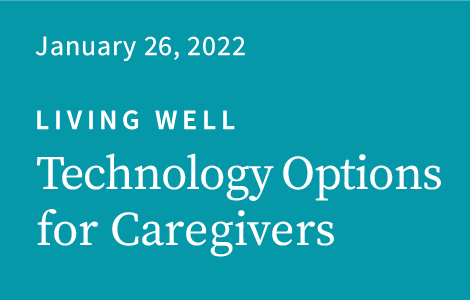Transcript
Technology Options for Caregivers
Over the years, technology has revolutionized our world and touched almost every part of our daily lives. So it should come as no surprise that there are tools to help care for people with dementia. My personal interest in these technologies was sparked by helping people living alone with dementia to stay at home as long as possible. However, you may be looking for ways to help care for someone you live with. There are many scenarios and many options. How technology can help you depends on your caregiving needs.
I’m going to describe some areas where technology might be useful. Please keep in mind that the technology solutions I mention are not endorsed by Bob’s Last Marathon, but serve to illustrate how technology might be of help in different situations.
Organizing the multifaceted care of people with dementia is a common and central challenge for caregivers, especially when several people are involved. There are apps to help you communicate important information and to coordinate care across family, friends, and professional help. One example is a calendar to arrange and manage visits, errands, or appointments. Other technology solutions can help organize and store health information, make checklists, and track things like medications.
One family I worked with used an app called Lotsa Helping Hands over the course of many years. They started using it while their loved one with dementia lived at home to coordinate outings and visits, as well as to schedule transportation to appointments and the adult day program. When their loved one was moved into a long-term care facility, they used it to share information and, again, to coordinate visits. When long-term facilities started restricting visits during the pandemic, the app was used to keep family and friends updated on how their loved one was faring, and how the facility was ensuring the safety of staff and residents.
Technology can also be used to monitor the home. Home monitoring and automation systems are akin to home security systems with added functions. Some systems allow you to program thermostats, lights, and appliances that a person with dementia may forget to adjust. You can find systems that include sensors attached to appliances, doors, and faucets. These systems may be self-monitored or professionally monitored.
You might not want a complex system. One or two specific products might be enough. For example, instead of an entire monitoring system, you might just need an overflow alarm for the tub or sink. Water sensors can catch leaks or floods before they cause too much damage. I know of several instances where a person with dementia left water running in a bathtub, causing damage to the home. There are stove shut-off products to allow the person living with dementia to continue cooking with less risk of burns or fires. Sensors or alarms attached to doors and windows can signal when your loved one unexpectedly leaves the house. Motion detectors that automatically turn on lights can help reduce the risk of falls.
Medication management systems can help you organize medications, remind people when to take their medications, and track refills—in this way reducing the risk of medication errors, a major safety benefit. When used by the person living with dementia, these apps may help promote independence, offer a sense of control, and promote safety.
Medication management systems vary from low-tech pillbox organizers to Wi-Fi–connected dispensing systems that automatically request medication refills. Some systems send notifications to the caregiver or pharmacy when a prescription runs low. Others include reminder alarms and/or locked compartments to help ensure medications are taken at the right time. I’ve known several people in the early stages of dementia living well on their own who used automated dispensing systems (medi-sets) to remind them to take their medication independently with less risk and worry about medication error.
Another way to support your loved one’s independence is to give them more freedom of mobility. Going out for a simple walk can be a rewarding act of independence. GPS tracking systems can help make it safer. The tracker may take the form of a wearable device like a watch, pendant, shoe insert, or keychain bauble, or a smartphone with an app. The caregiver can use their phone or computer to check the person’s location. Some trackers allow you to set up zones and alert you when the person goes beyond the boundary. For people who wander, trackers may also be enormously helpful in quickly locating them. As with any device, it’s important to make sure the trackers are fully charged.
Tracking systems can also help with the very common problem of finding misplaced items. One person told me they started a decluttering campaign just so they had fewer things to search through. Trackers that can be attached to important items such as eyeglasses and keys can use GPS, Bluetooth, radiofrequency identification, or crowd networking. For example, the Orbit tracker fits onto the arm of eyeglasses, making them easier to find and reducing frustration.
Keeping a person living with dementia involved in activities is good for their emotional and cognitive well-being. While electronic and virtual activities have existed for years, they became more critical and widely used when in-person activity programs were shuttered due to COVID.
Games, crafts, and exercise programs are easily accessed through phones, tablets, and computers. A quick look at the app store on your device will display a multitude of word games, jigsaw puzzles, art and coloring programs, and other interactive and solo activities. You can customize photobooks and playlists. Take a virtual trip to a Hawaiian volcano or the Smithsonian museums. Or peek in on the lives of animals via live camera feeds—with everything from lively videos of penguins to soothing images of jellyfish and kelp forests.
This brief overview is by no means an exhaustive list of technologies available to caregivers, but covers the ways I’ve seen them used by others. Hopefully it will point you in the right direction. Like technology in all areas of our lives, the options for caregivers change quickly. Keep your eyes open for helpful tools in the future.
Stefanie Bonigut, LCSW

